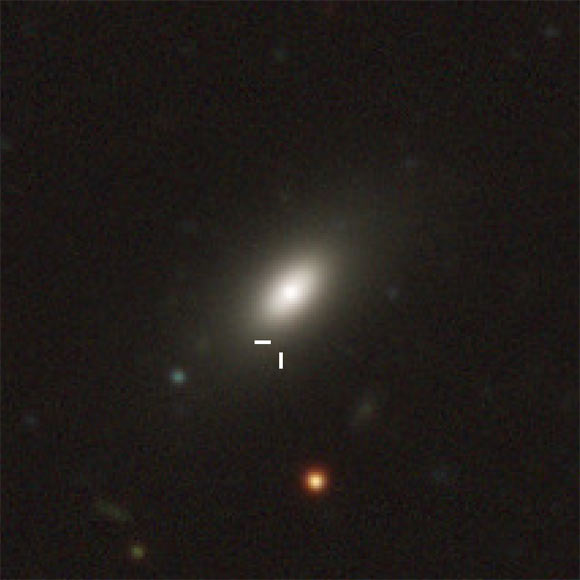TESS Observes Unusual Type Ia Supernova: ASASSN-18tb | Astronomy – Sci-News.com
Astronomers have used NASA’s Transiting Exoplanet Survey Satellite (TESS) to see what was happening around the supernova ASASSN-18tb in the first moments after it exploded — an unprecedented opportunity.

This image from Data Release 1 of the Dark Energy Survey shows 2MASX J04180598-6336523, the host galaxy of the Type Ia supernova ASASSN-18tb; the position of the supernova is marked by the white ticks. Image credit: Kollmeier et al, doi: 10.1093/mnras/stz953.
ASASSN-18tb is a Type Ia supernova, a type of stellar explosion that can occur when two stars orbit one another — what astronomers call a binary system. In some cases of a Type I supernova, one of those stars is a white dwarf.
A white dwarf has burned off all its nuclear fuel, leaving behind only a very hot core. Unless the star grows bigger by stealing bits of energy and matter from a nearby star, the white dwarf spends the next billion years cooling down before turning into a lump of black carbon.
But if the white dwarf and another star are in a binary system, the white dwarf slowly takes mass from the other star until, eventually, the white dwarf explodes into a supernova.
“Type Ia is the most famous type of supernova — they led to dark energy being discovered in the 1990s,” said Ohio State University astronomer Patrick Vallely.
“They are responsible for the existence of so many elements in the Universe. But we don’t really understand the physics behind them that well.”
Vallely and colleagues combined data from TESS and the All-Sky Automated Survey for Supernovae (ASAS-SN) with data from the South African Large Telescope (SALT) to evaluate the elements left behind in the wake of ASASSN-18tb.
They found both hydrogen and helium there, two indicators that the exploding star had somehow consumed a nearby companion star.
“What is really cool about these results is, when we combine the data, we can learn new things,” said Ohio State University’s Professor Kris Stanek.
“And this supernova is the first exciting case of that synergy.”
“We have known for years that these stars explode, but we have terrible ideas of why they explode,” Vallely said.
“The big thing here is that we are able to show that ASASSN-18tb isn’t consistent with having a white dwarf (take mass) directly from a standard star companion and explode into it — the kind of standard idea that had led to people trying to find hydrogen signatures in the first place.”
“That is, because the TESS light curve doesn’t show any evidence of the explosion slamming into the surface of a companion, and because the hydrogen signatures in the SALT spectra don’t evolve like the other elements, we can rule out that standard model.”
“Our findings provide some evidence that the companion star in this type of supernova is likely another white dwarf,” Professor Stanek said.
“We are seeing something new in these data, and it helps our understanding of the Type Ia supernova phenomenon. And we can explain this all in terms of the scenarios we already have — we just need to allow for the third star in this case to be the source of the hydrogen.”
The results were published in the Monthly Notices of the Royal Astronomical Society.
_____
P.J. Vallely et al. 2019. ASASSN-18tb: a most unusual Type Ia supernova observed by TESS and SALT. MNRAS 487 (2): 2372-2384; doi: 10.1093/mnras/stz1445





